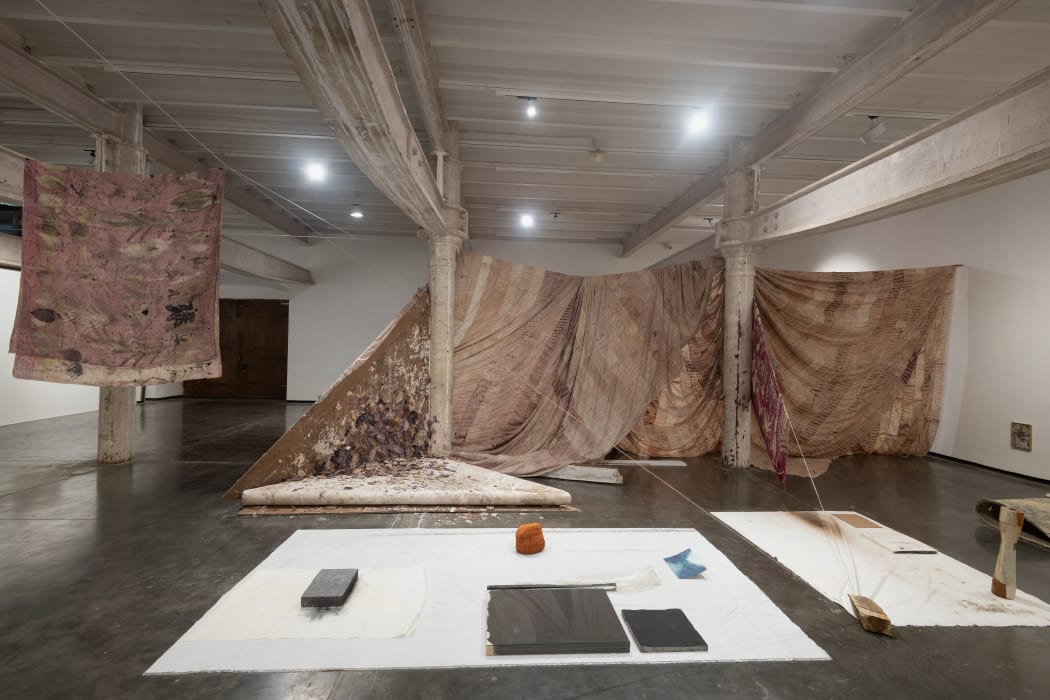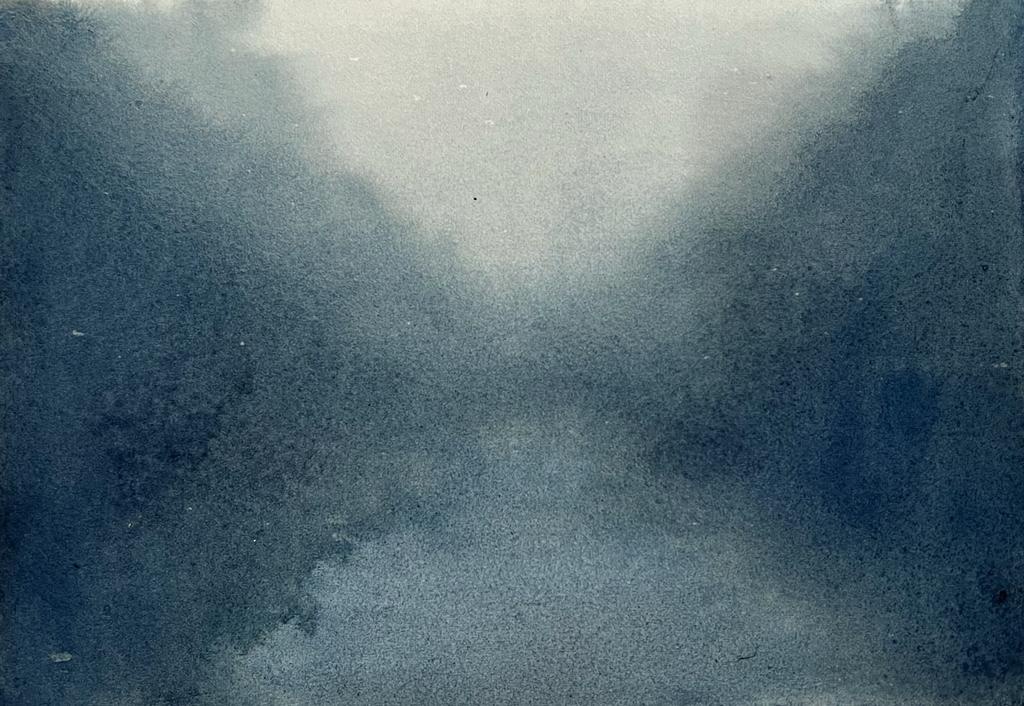
“An exhibition is a temporary realization of something that we want to be perceived on a level beyond whatis visible.” [1]
There is a gentleman dressed in his mother’s sari sitting among us.
We are in the presence of a decade of works by Hemali Bhuta, or as he would say, we are seeing them “in the flesh”. We are letting them fill us… bleed on us…We came for this, we were waiting for this… at times solemnly, at times giggling…
Like in Marguerite Duras’ writings, ellipses have become our way of communicating…
In Duras’ novel Moderato Cantabile, Anne says: “I would like you to never stop talking…
Closure is resisted…Always… Inconclusions…
We are reading while writing… A candle is lit. Immense sadness…
A painting in indigo of a photo taken by the gentleman of the Subarnarekha river appears on my screen.
“Infinite time rocks the earth, the ebb and flow of the tide. The world turns. My pulse is beating and my veins throbbing. And in wonder, my song bursts forth” [2]

Hemali Bhuta, 10/09/21, 6.33 PM, Indigo on paper, 20 x 25 cm, 2022
In Aha! we see three bodies of connected work come together. The gallery inventory from previous exhibitions by Hemali, Measure of a foot, Subarnarekha, and and the epic did not happen! are gathered and densely displayed in one room. This iteration is not only the assembling of three shows but also of ideas, temporalities and people.
The triangle becomes a line that becomes a triangle…
May we write lac with a “k” this time?
Between the two parts, there is a long fading heartbreaking breath…
The title: the absurdity evoked, the personal dimension. The epic happened…
A cotton kimono… A pocket book…
During the opening of and the epic did not happen! I placed a pocket call to our whatsapp group. Later on, we laughed at your spectral appearance on my screen. The love and ghostly presence/absence—as you would say—is still tangible.
A great boredom has descended....
“That is, we may no longer be able to create but what we can do is to wipe the dust off the surface of things and let the world that it is a part of, appear.” [3]
The opening of boxes that have been stored for many years…The uncertainty, the emotions… The new autonomy the works receive from this action. Each work presented is in the state of becoming… Making as continuity, “as process of growth…” Hemali continues to expand the traditional notion of sculpture and to interrogate the status of the art object. The unwillingness to complete anything…
Remembering opening the folded carpet piece for and the epic did not happen!…The tension, the awe…The wish at that time that we were all in that same room… but we were in a way…
“I want to think of making instead, as a process of growth. This is to place the maker from the outset as a participant in amongst a world of active materials. These materials are what he has to work with, and in the process of making he ‘joins forces with them, bringing them together or splitting them apart, synthesizing and distilling, in anticipation of what might emerge.” [4]
There is something radical in Hemali’s gesture to bring what remains of a decade of artistic production into one room… works that were less noticed… A new dynamic is brought up… a reawakening… What has become of these works that were stored for years? The notion of what an artwork is, both materially and temporally, is interrogated further … The artist coming up with her own terms…
The thread of a river is running through them. The Tajna (the red river) for the body of work that originated with the artist’s research on lac, and the Subarnarekha (gold or black river) for the body of work related to her research on gold.
“The blood red in the river does meet the gold in the river Subarnarekha which is now known to be black river with all its contamination through all kinds of mining practices around it.” [5]

Hemali Bhuta, In the midst of this, I find my place, Handmade shellac of different shades, 94 x 109 x 13 cm, 2021
Both rivers physically meet in Jharkhand though, for the artist, they symbolically meet in Bengal. Subarnarekha—also the title of one of Ritwik Ghatak’s films in his trilogy about partition—bears stories of displacement… of pollution…
From Subarnarekha, there are miniature gold models of works that were included in Measure of a foot. Maquettes as afterthoughts or as future memorials… or present ones…
The red seed of the acacia coral was used as a measure for gold on weighted scales in Jharkhand.
“Many of the works in Measure of a foot, Hemali Bhuta’s current exhibition at Project 88, were made by means of unmaking what were once finished works in Point-Shift and Quoted Objects, her previous solo [exhibition] at the gallery. Materials carry their own geologies, and in this body of work the artist goes back in time to bring something forth from that which remains. These processes of transmutation are invisible to us as viewers, but nonetheless suggest that the works of art, and the matter they contain, belong to a continuum. Lying on the ground, they are future memorials to their former selves.” [6]
Three chapters—and their sensoria—are coming together in a single locus, closing a cycle in Mumbai after Vassiviere and New York.
An artist that shuffles things, processes and timelines.
A consistent and uncompromising engagement with materials.
What is brought forth this time in the making, unmaking and remaking?
We are told most of the stories around gold and lac suggest death.
Lac-filled gold bangles…
The absence of visual narrative does not mean there is no narrative.
“In my mind, I do know that they meet at some point. In the landscape, due to the landscape and also due to my encounters with the landscape and the people.” [7]
By summoning these past works and fragments, and assembling them in this concise way, a sort of archive is constituted. Though, somehow, the gallery space becomes their place of revival and their repository at the same time… at least for a moment… One wonders if this chapter will be the works’ last stop…

Hemali Bhuta, A gift, series from the garden of CONA, Goa. Collaboration with Gorika Singla, Botanical print on silk, lac, 120 x 240 cm, 2022
One dying rose this morning…
This time, so many affective sensations arising from matter…
Thinking of Passport by Felix Gonzalez-Torres…
Smelling a lavender sprig in order to remember the smell of lac resin…
A shared love for chiaroscuro and moonlight… and of Joachim Patinir’s Charon crossing the Styx.
“I know when one is dead, and when one lives…” [8]

Hemali Bhuta, One can meditate on that, 2020-2021
With the most recent works included in Aha! we are reminded of the artist’s interest in domestic gestures and encounters: be it the drying of clothes on a line, sweeping the floor, or grinding spices.
Her photographs of drying saris at the dhobi ghat , though disembodied, present a repertoire of postures.
The life and loss intrinsic to the medium of photography is emphasized here.
Eco-printing, a dyeing technique where the color of the plant is transferred to paper or in this instance fabric, has been used to record the vegetable world in the CONA garden in Goa. This is a poignant counterpoint to the cyanotypes on cotton that were shown a year ago in New York and that presented the vegetable world of the CONA garden in Mumbai.
Madder, lac and cochineal dyes…
The sharpness of the contours of the leaves…
The elliptical and the tangible… a space… an invocation…A space…
Recordings…stillness… relics… Lives and losses…
A text that must be (re)read.
Energy dialogue… Invisible forces carried by the materials…
A landscape as a shrine… a shrine as a landscape…
May be a space opening another space…
“Yet, I also feel that the convergence of the two, rather than resulting in the annihilation of any one of them, will produce a third thing. heaven knows what that thing will be, but it will be the fruit of something generative, of value, and eventually productive of something like love—eros, in the largest, deepest sense of the word. perhaps that third thing will need a radical reconstitution and reconfiguration of the space in which it can be sustained, nurtured, valued, shared, kept; perhaps that reconfigured space will not, and cannot, be solely the space of what we have been calling ‘art’, and every kind of interaction, process, exchange, attention around and in that space will be fundamentally different, radically at odds with the domestic, the professional, the commercial, the imaginative, the aesthetic, the interpersonal, even the impersonal, but transforming all these things and the relationships among these things. in that new space we would have to allow ourselves to be true, mad, humane, alert, authentic, humble and utterly honest without aggrandizing ourselves into heroic creatures, but also without undermining ourselves and one another. there will be tending and there will be wounding.” [9]
There is solace in this offering…
May we all feel its vital undercurrent.
________________
[1] Harald Szeemann, Wolfgang Laib, catalogue – ARC Musee d’art moderne de la Ville de Paris, 1986
[2] Rabindranath Tagore, Akash Bhora Surjo Tara as quoted in Ritwik Ghatak’s Komal Gandhar, 1961
[3] Kishio Suga, The Start of Disappearance : As Things Deny Things, 1969
[4] Tim Ingold, Making: Anthropology, Archaeology, Art and Architecture, 2013
[5] Hemali Bhuta in correspondence with Aveek Sen and Anne Couillaud
[6] Nida Ghouse, On entering a quarry for Measure of a Foot, Project 88, Mumbai, 2016
[7] Hemali Bhuta in correspondence with Aveek Sen and Anne Couillaud
[8] William Shakespeare, King Lear, 1605-06
[9] Aveek Sen in correspondence with Hemali Bhuta and Anne Couillaud

